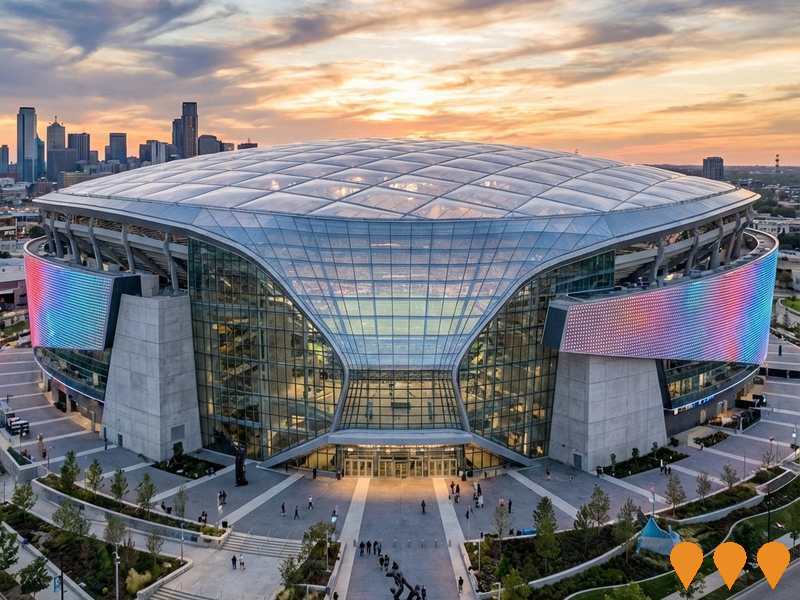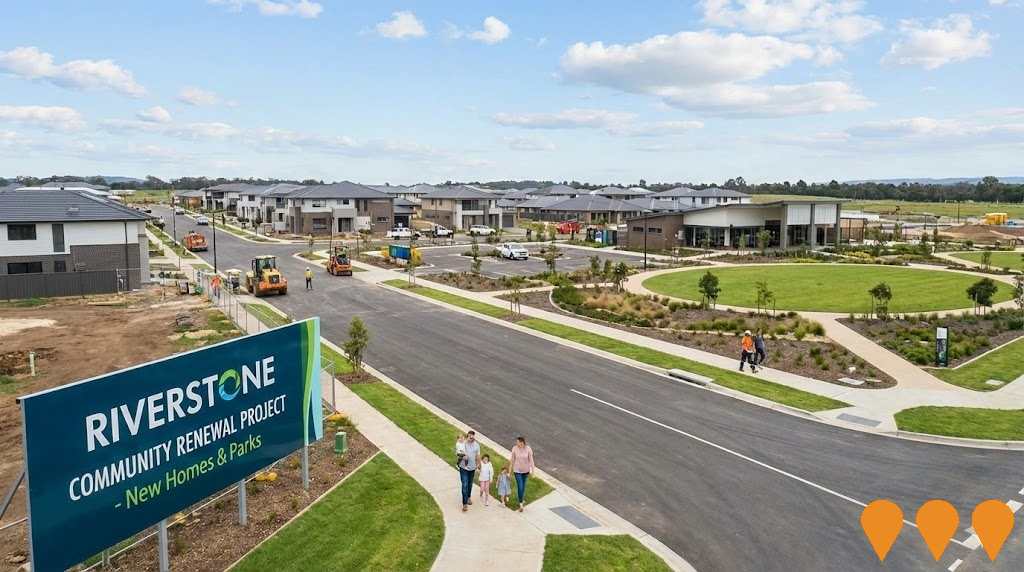Chart Color Schemes
est. as @ -- *
ABS ERP | -- people | --
2021 Census | -- people
Sales Activity
Curious about local property values? Filter the chart to assess the volume and appreciation (including resales) trends and regional comparisons, or scroll to the map below view this information at an individual property level.
Find a Recent Sale
Sales Detail
Population
Fortitude Valley lies within the top 10% of areas nationally in terms of population growth performance according to AreaSearch analysis of short and medium-term trends
Fortitude Valley's population, as of Aug 2025, is approximately 11,557. This figure represents an increase of 2,045 people since the 2021 Census, which reported a population of 9,512. The change is inferred from ABS data showing an estimated resident population of 11,545 as of June 2024 and an additional 349 validated new addresses since the Census date. This results in a population density ratio of 9,100 persons per square kilometer, placing Fortitude Valley in the top 10% of national locations assessed by AreaSearch. The area's 21.5% growth since the 2021 census exceeds both the national average (8.6%) and the state average, indicating it is a growth leader in the region. Overseas migration contributed approximately 68.2% of overall population gains during recent periods, although all drivers including interstate migration and natural growth were positive factors.
AreaSearch adopts ABS/Geoscience Australia projections for each SA2 area, released in 2024 with 2022 as the base year. For areas not covered by this data and years post-2032, Queensland State Government's SA2 area projections are adopted, released in 2023 based on 2021 data. However, these state projections do not provide age category splits, so AreaSearch applies proportional growth weightings in line with ABS Greater Capital Region projections for each age cohort, released in 2023 based on 2022 data. Looking ahead, exceptional population growth is predicted over the period to 2041, with Fortitude Valley expected to grow by 6,830 persons, reflecting an increase of 59.0% in total over the 17 years.
Frequently Asked Questions - Population
Development
Residential development activity is slightly higher than average within Fortitude Valley when compared nationally
Fortitude Valley averaged approximately 125 new dwelling approvals annually. Between FY-21 and FY-25, a total of 626 homes were approved, with none yet recorded in FY-26. On average, each constructed dwelling attracted four new residents over the past five financial years.
This high demand coupled with relatively low supply typically drives price growth and increased buyer competition. In FY-26 alone, $230.2 million worth of commercial approvals have been granted, indicating robust local commercial activity. Compared to Greater Brisbane, Fortitude Valley exhibits 14.0% lower construction activity per person but ranks in the second percentile nationally for assessed areas, leading to limited buyer choice and interest in existing homes. Notably, all new constructions since FY-21 have been medium or high-density housing, offering more affordable entry points for downsizers, investors, and first-home buyers.
By 2041, Fortitude Valley is projected to add 6,818 residents. Given current development rates, housing supply may struggle to keep pace with population growth, potentially intensifying buyer competition and supporting price increases.
Frequently Asked Questions - Development
Infrastructure
Fortitude Valley has moderate levels of nearby infrastructure activity, ranking in the top 50% nationally
Changes to local infrastructure significantly influence an area's performance. AreaSearch has identified 70 projects likely to impact the area. Notable projects include Brunswick & Co, James Place, The Bedford by Mosaic, and Brisbane 2032 Games Venue Infrastructure Program. The following list details those most relevant.
Professional plan users can use the search below to filter and access additional projects.
INFRASTRUCTURE SEARCH
 Denotes AI-based impression for illustrative purposes only, not to be taken as definitive under any circumstances. Please follow links and conduct other investigations from the project's source for actual imagery. Developers and project owners wishing us to use original imagery please Contact Us and we will do so.
Denotes AI-based impression for illustrative purposes only, not to be taken as definitive under any circumstances. Please follow links and conduct other investigations from the project's source for actual imagery. Developers and project owners wishing us to use original imagery please Contact Us and we will do so.
Frequently Asked Questions - Infrastructure
Brisbane 2032 Games Venue Infrastructure Program
The $7.1 billion Games Venue Infrastructure Program involves the planning and delivery of 17 new and upgraded venues across Queensland, including the new 63,000-seat Brisbane Stadium at Victoria Park and the National Aquatic Centre. Led by the Games Independent Infrastructure and Coordination Authority (GIICA), the program aims to deliver long-term sporting and community legacy benefits for Brisbane and regional Queensland.
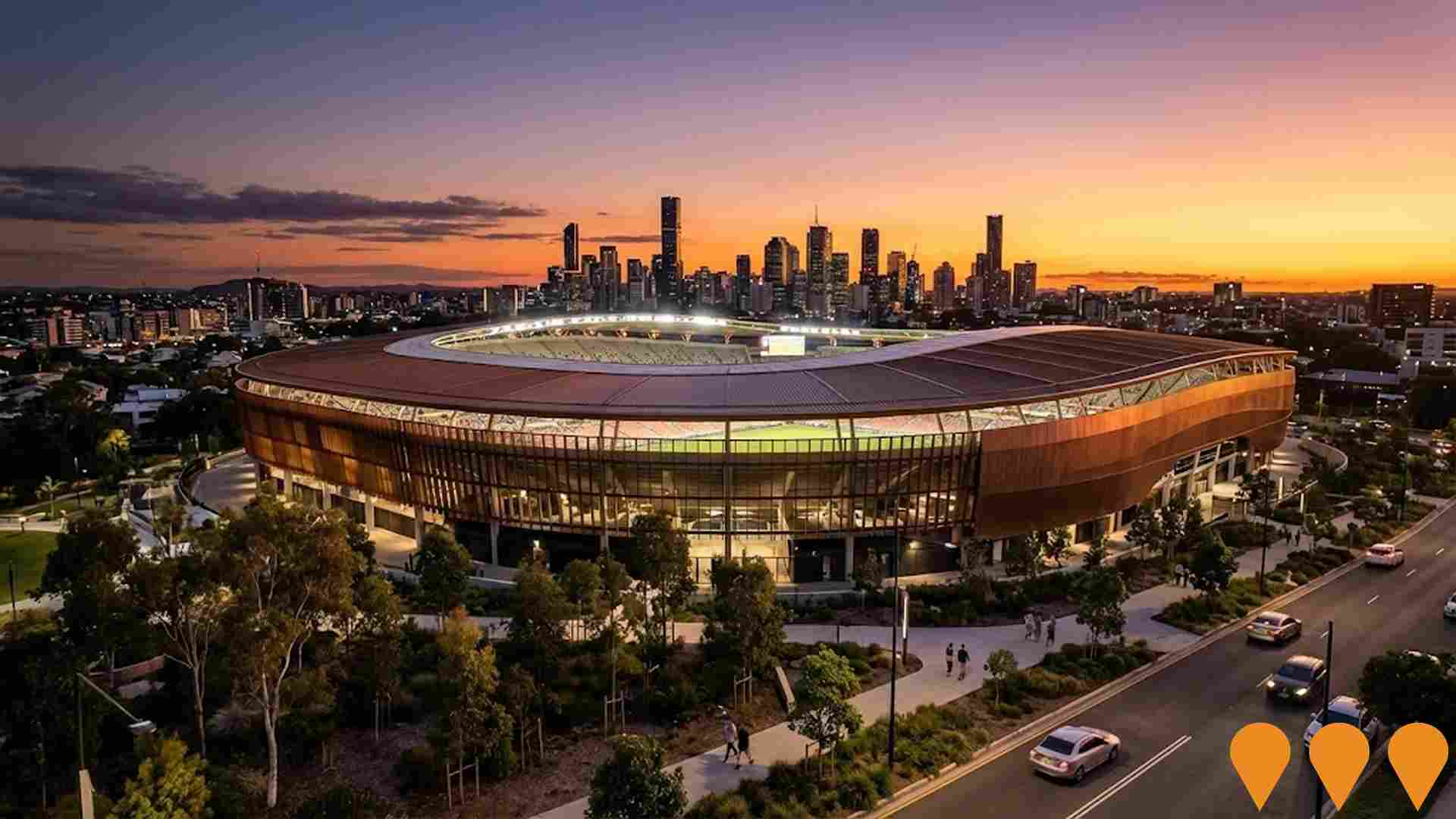
Brisbane Athletes Village - RNA Showgrounds
The primary Olympic and Paralympic Athletes Village for Brisbane 2032 at the RNA Showgrounds in Bowen Hills. Accommodates over 10,000 Olympic athletes and 5,000+ Paralympic athletes during the Games. Includes upgrade of the Main Arena to 20,000 seats and restoration of heritage grandstands. Early works commenced August 2025. Post-Games, the site will deliver up to 3,000 new permanent dwellings as part of Queensland's housing legacy, relocated from the original Northshore Hamilton proposal to save at least $2 billion. Excellent connectivity via Exhibition Station and Cross River Rail.
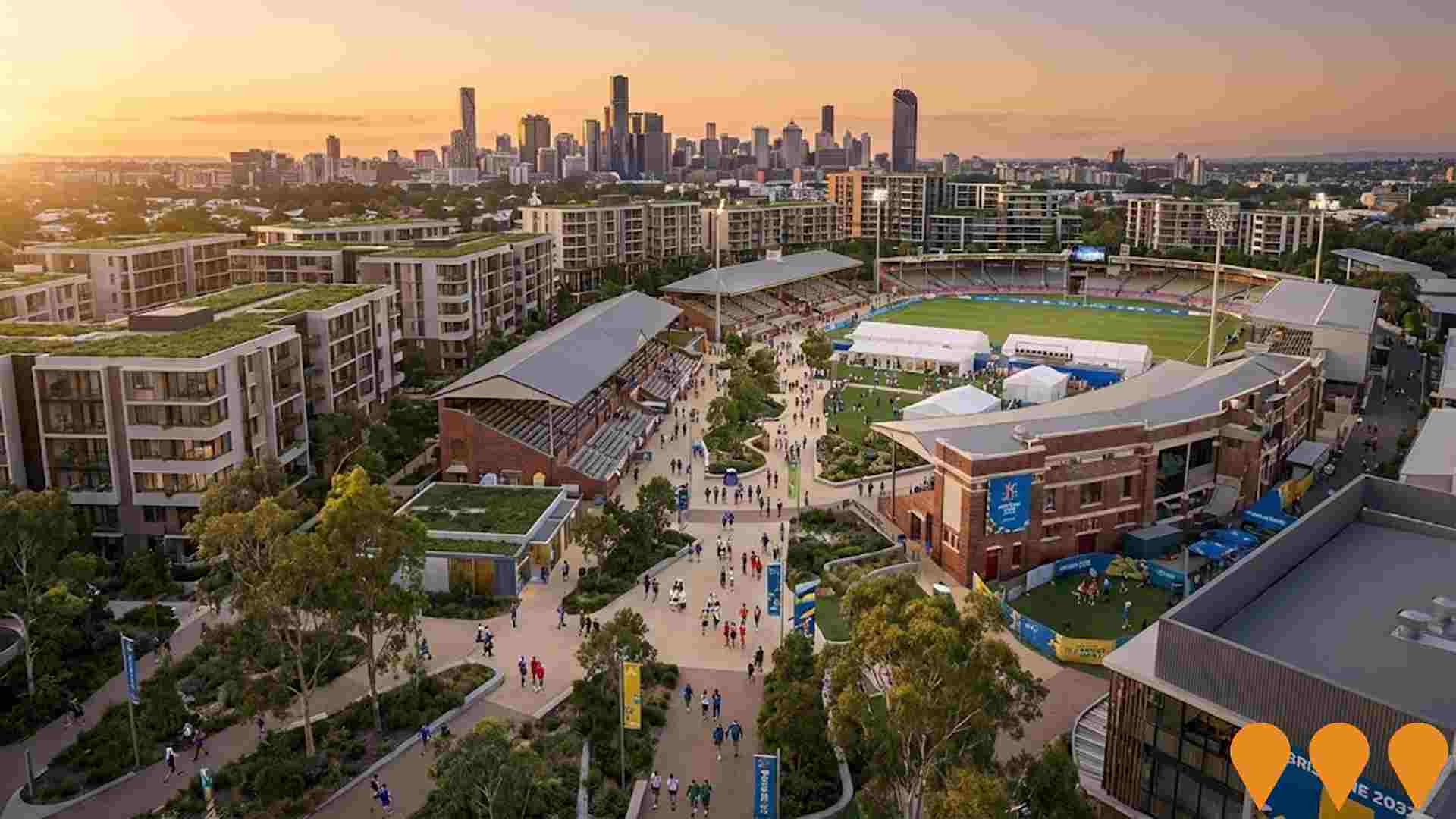
James Place
James Place is a landmark mixed-use development by Forme at 75-85 James Street, Fortitude Valley. Designed by Richards & Spence with landscaping by Wild Studio and constructed by Graya, the six-level project features over 8,700sqm of premium boutique retail, hospitality, wellness, and commercial office space, a lush central piazza, dual street frontages, an arcade connecting James Street to Southwick Lane, landscaped terraces, and an elevated rooftop venue with city views. Construction commenced mid-2024, with completion targeted for early 2026.
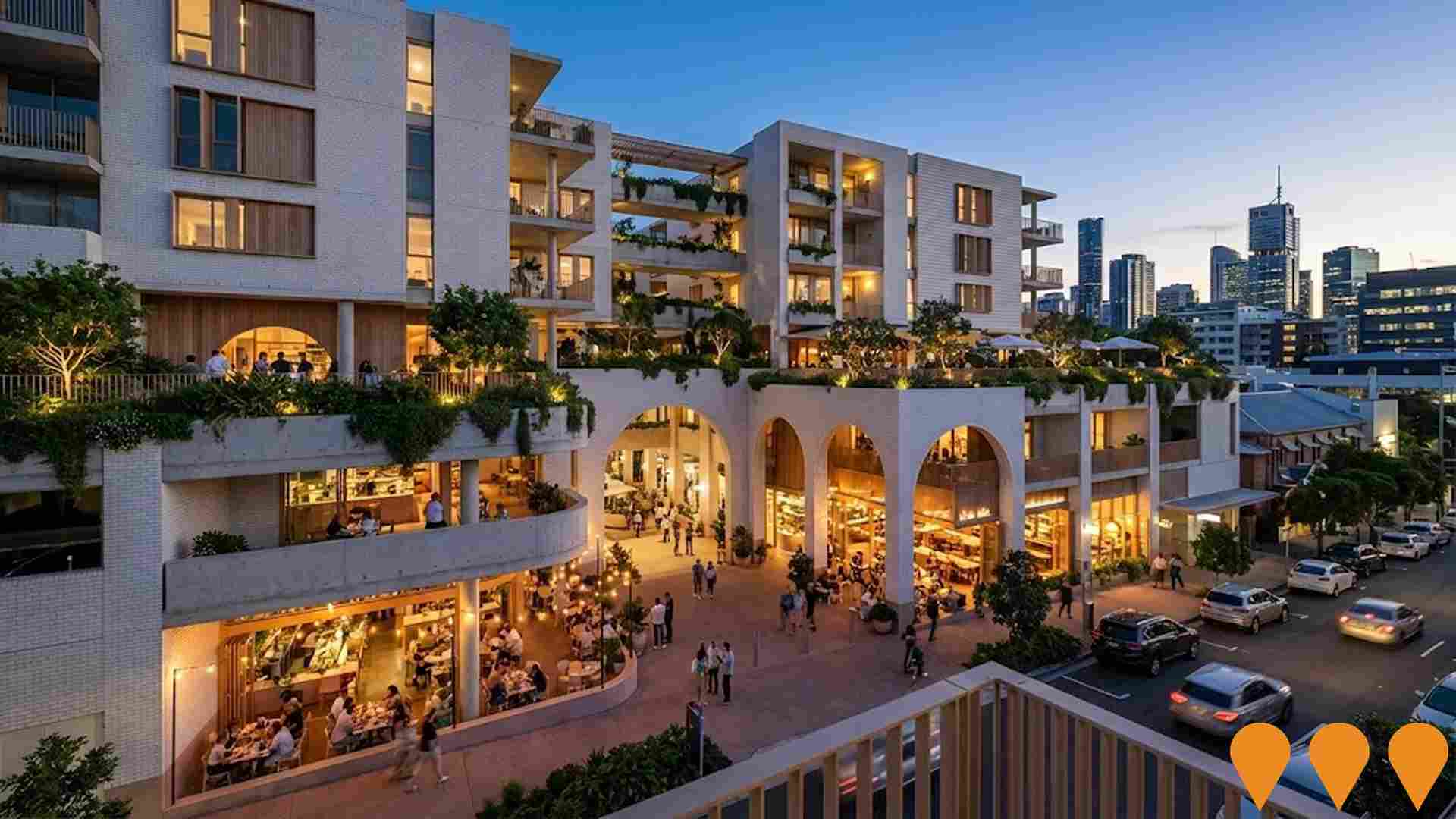
Brunswick & Co
Queensland's first true Build-to-Rent high-density residential development featuring 366 apartments across 25 storeys, including 144 subsidised affordable housing units. The project showcases resort-style amenities including rooftop pool, dog park, fitness studio, co-working spaces, cinema rooms, and ground-floor retail. Designed by COX Architecture and built by Hutchinson Builders, it targets 5-Star Green Star certification with 100% renewable energy and all-electric design. Part of the Queensland Government's BTR Pilot Project, located adjacent to the $500 million Valley Metro redevelopment in Fortitude Valley's entertainment precinct.
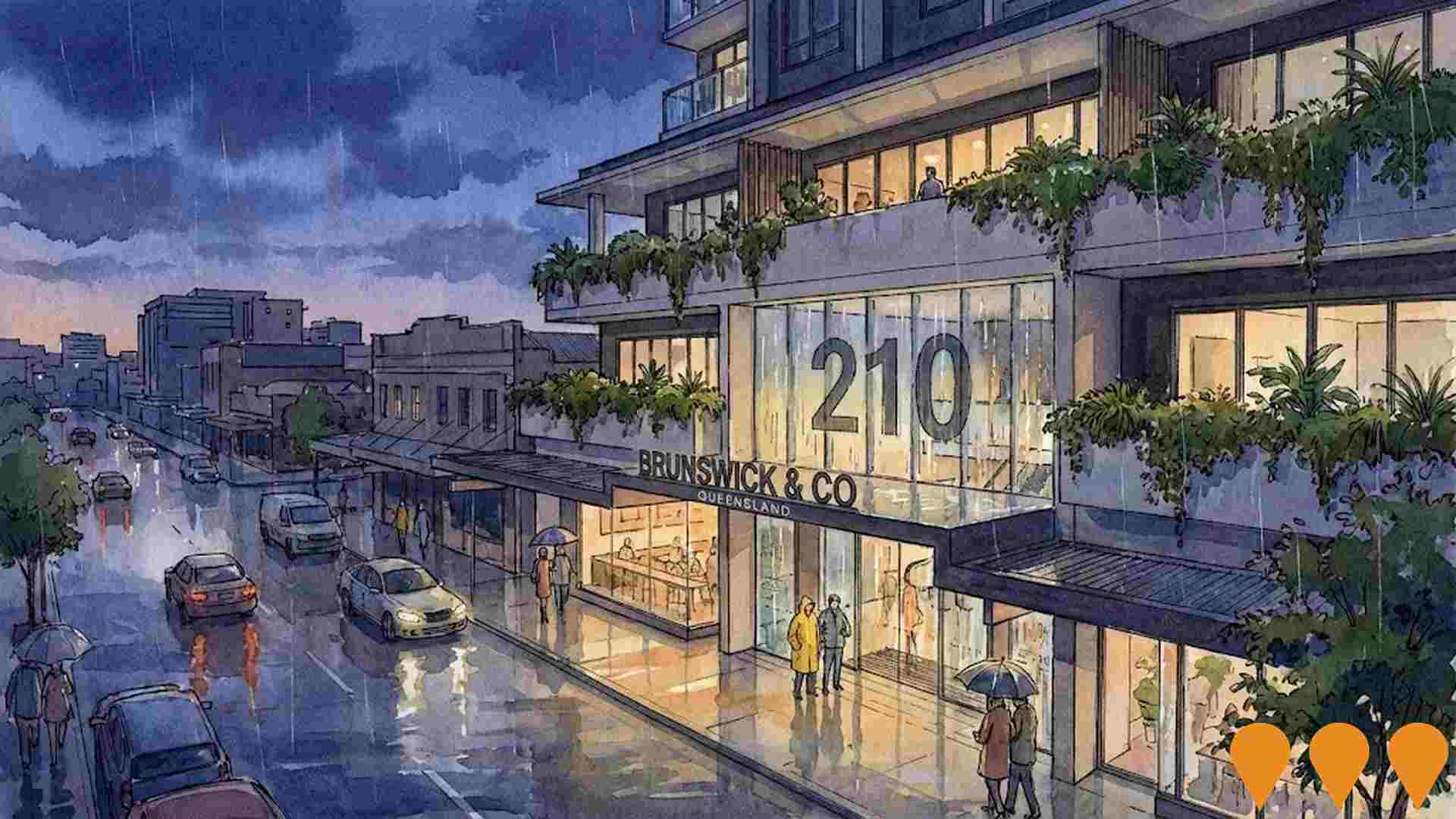
The Bedford by Mosaic
Landmark $310 million 17-storey mixed-use development featuring 128 luxury apartments and ground-floor Woolworths supermarket. First major development in Kangaroo Point in over a decade, designed by BDA Architecture with resort-style amenities and river views. Achieved $210 million in pre-sales within first two weeks. Includes 2,236sqm Woolworths supermarket, cafe, liquor store, and extensive basement parking.
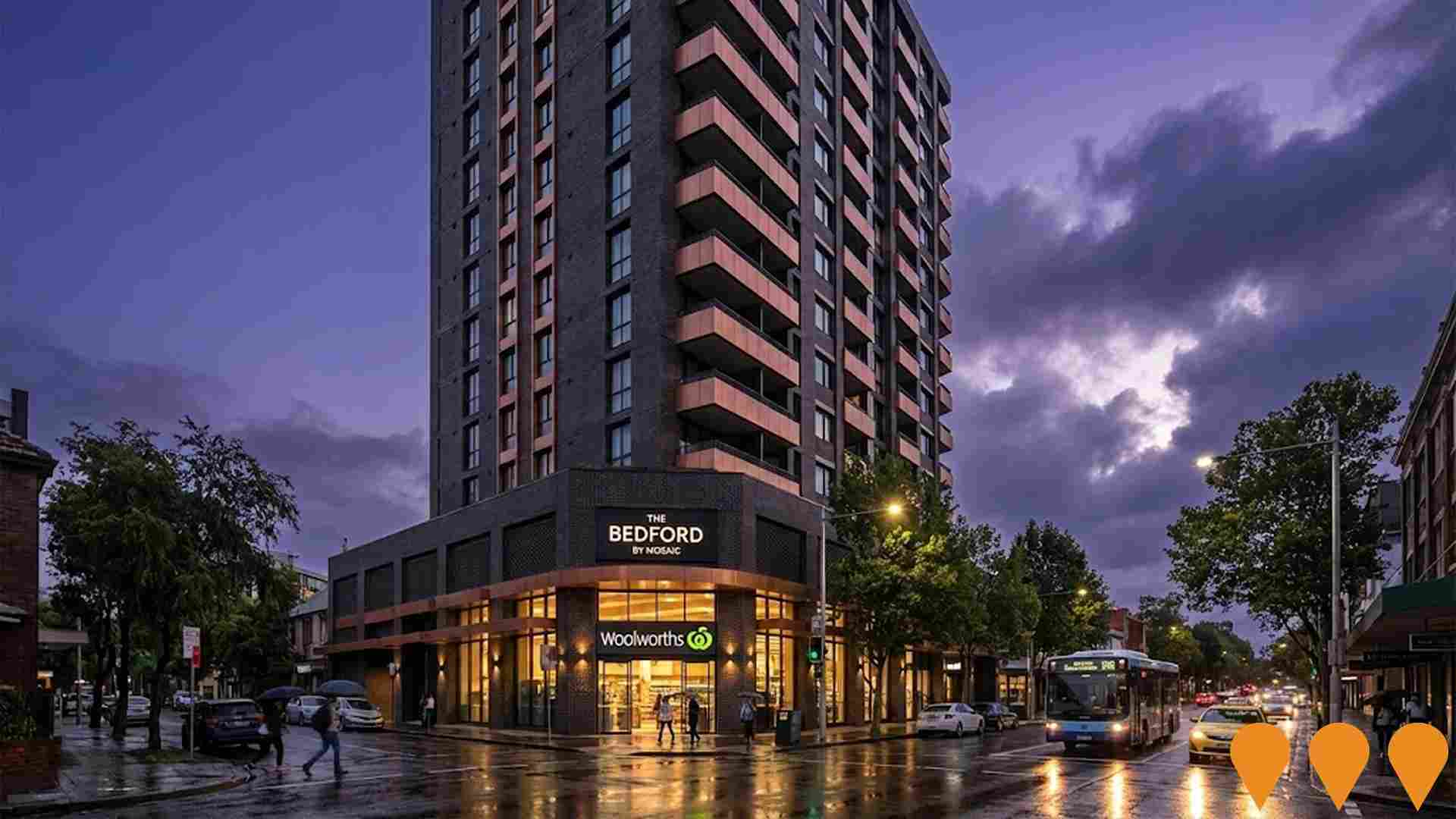
Affordable Housing Development
Social and affordable housing development providing 150 apartments for low-to-moderate income households. The development includes community spaces and is designed to integrate with the existing neighborhood character.
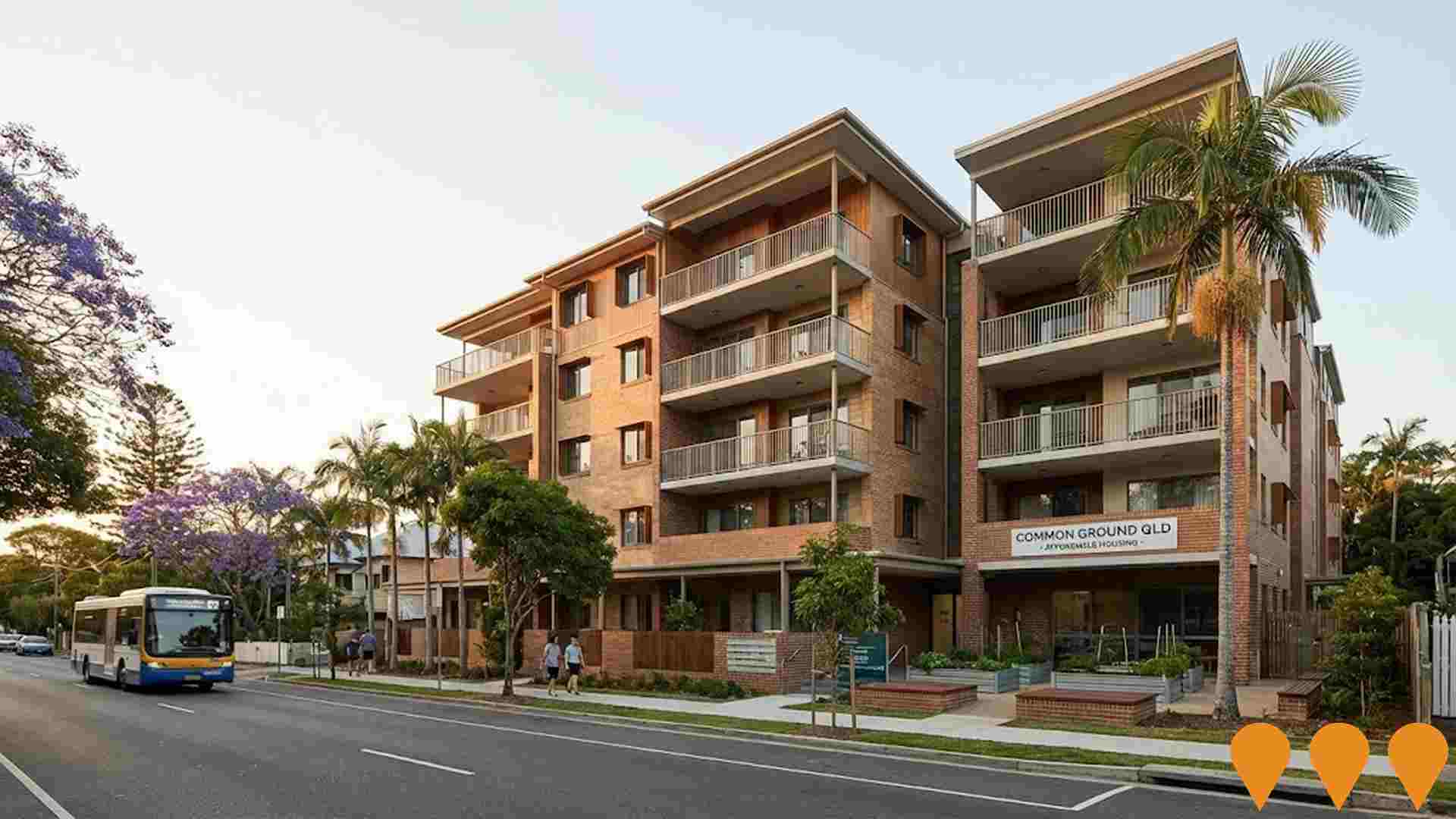
801 Ann Street Twin Towers
Approved dual 33-storey mixed-use tower development by EG Funds Management, designed by Rothelowman. Delivers 551 apartments (326 Build-to-Rent and 225 Build-to-Sell), over 1,000 sqm retail space, 300 sqm community facility operated by Little B.I.G Foundation, rooftop pools, BBQs, gym, wellness spa, library, and extensive subtropical landscaping including the publicly accessible Quandong Common. Targets 5 Star Green Star certification.
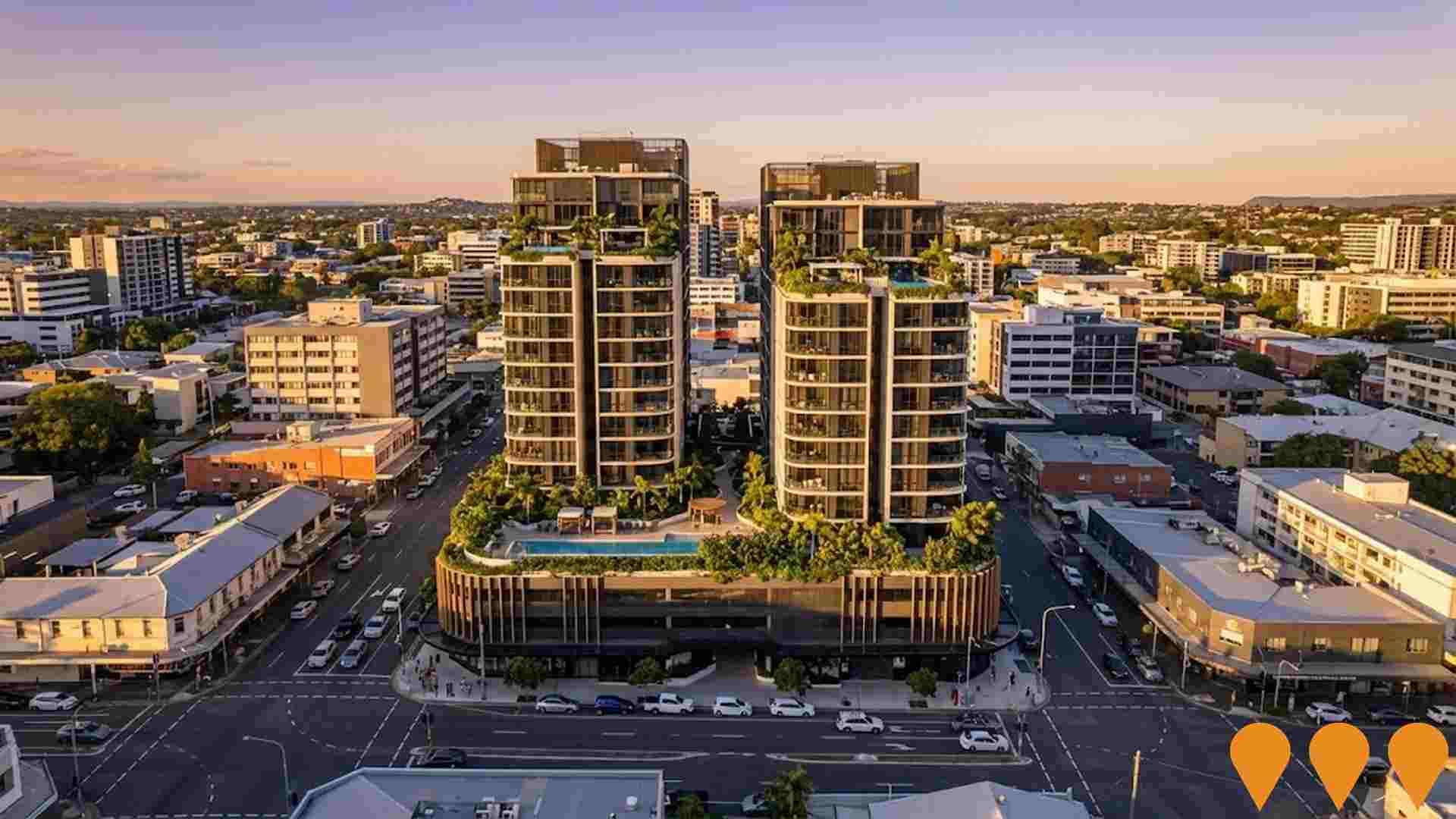
The Fortitude Valley Place
Major urban renewal project in Fortitude Valley featuring mixed-use development with residential, commercial, retail and public spaces. Integration of transport infrastructure and community amenities.
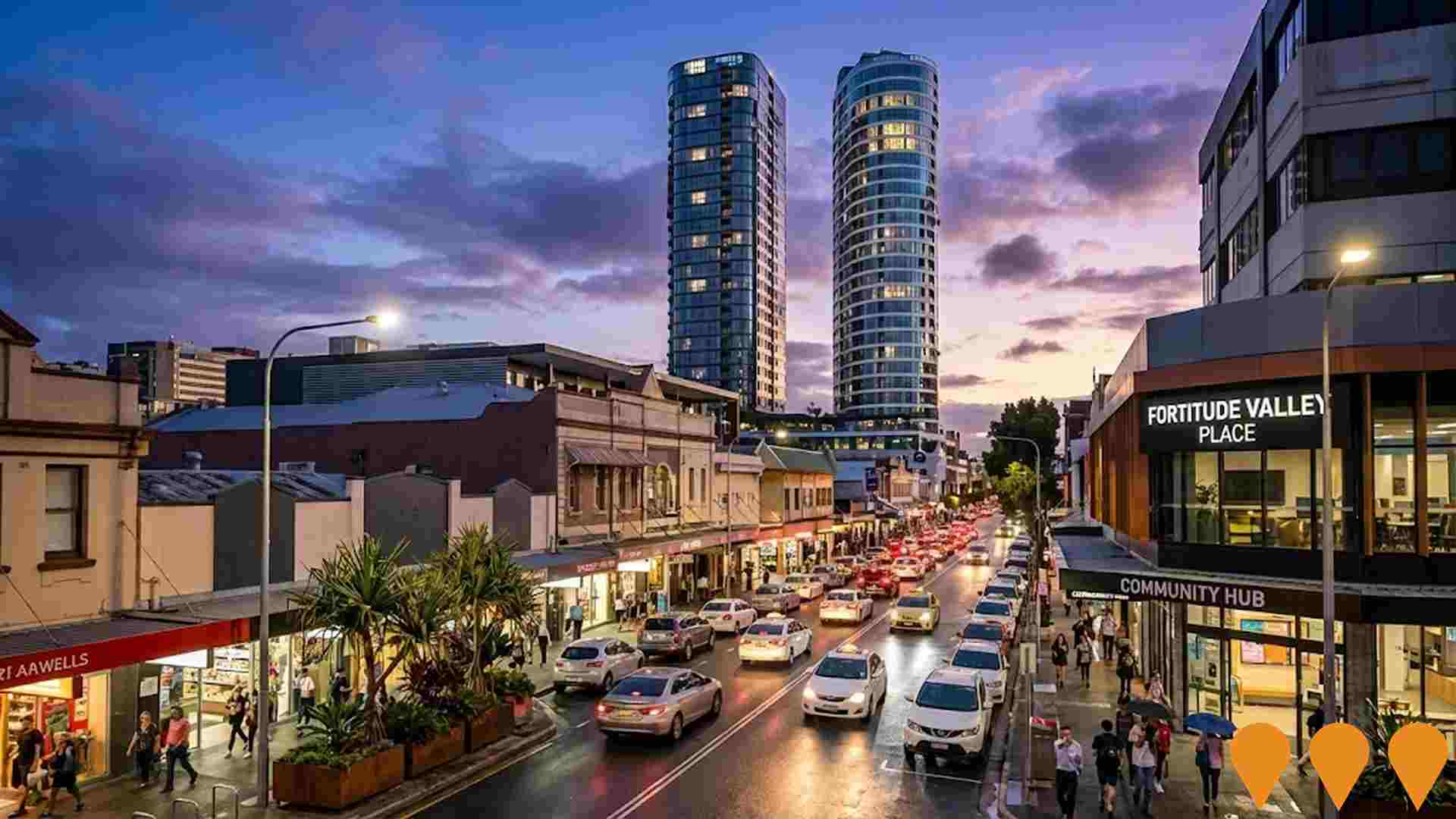
Employment
Fortitude Valley has seen below average employment performance when compared to national benchmarks
Fortitude Valley has a highly educated workforce with strong representation in professional services. Its unemployment rate is 6.1%, with an estimated employment growth of 4.0% over the past year (as of June 2025).
There are 8,905 residents employed, with an unemployment rate at 2.0% above Greater Brisbane's rate of 4.1%. Workforce participation is high at 77.6%, compared to Greater Brisbane's 64.5%. Employment is concentrated in professional & technical services (35%), accommodation & food services (28%), and health care & social assistance (19%). The area has a particularly strong specialization in accommodation & food services, with an employment share of 2.2 times the regional level.
Conversely, education & training shows lower representation at 5.1% compared to the regional average of 9.4%. There are 2.9 workers for every resident, indicating that Fortitude Valley functions as an employment hub hosting more jobs than residents and attracting workers from surrounding areas. Over a 12-month period ending June 2025, employment increased by 4.0% while the labour force grew by 3.0%, causing the unemployment rate to fall by 1.0 percentage points. In contrast, Greater Brisbane experienced employment growth of 4.4% and labour force growth of 4.0%, with a drop in unemployment rate by 0.4 percentage points. According to Jobs and Skills Australia's national employment forecasts from May 2025, national employment is forecast to expand by 6.6% over five years and 13.7% over ten years. Applying these projections to Fortitude Valley's employment mix suggests local growth of approximately 6.9%% over five years and 14.0% over ten years.
Frequently Asked Questions - Employment
Income
Income analysis reveals strong economic positioning, with the area outperforming 60% of locations assessed nationally by AreaSearch
AreaSearch's aggregation of ATO data for financial year 2022 shows Fortitude Valley had a median taxpayer income of $60,250 and an average income of $81,488. These figures are among the highest in Australia, compared to Greater Brisbane's median of $55,645 and average of $70,520. Based on Wage Price Index growth since financial year 2022, current estimates for Fortitude Valley would be approximately $68,679 (median) and $92,888 (average) as of September 2025. Census 2021 data shows individual earnings rank at the 84th percentile nationally ($1,059 weekly), while household income ranks at the 46th percentile. The predominant income cohort in Fortitude Valley is 38.3% (4,426 people) earning $1,500 - 2,999 per week, similar to the surrounding region's 33.3%. Housing affordability pressures are severe, with only 77.4% of income remaining after housing costs, ranking at the 39th percentile nationally. The area's SEIFA income ranking places it in the 8th decile.
Frequently Asked Questions - Income
Housing
Fortitude Valley features a more urban dwelling mix with significant apartment living, with a higher proportion of rental properties than the broader region
Fortitude Valley's dwelling structure, as per the latest Census, consisted of 1.5% houses and 98.4% other dwellings (semi-detached, apartments, 'other' dwellings). In contrast, Brisbane metro had 12.9% houses and 87.2% other dwellings. Home ownership in Fortitude Valley was at 5.4%, with mortgaged dwellings at 14.3% and rented ones at 80.2%. The median monthly mortgage repayment in the area was $1,733, lower than Brisbane metro's $2,000. The median weekly rent figure for Fortitude Valley was $400, compared to Brisbane metro's $440. Nationally, Fortitude Valley's mortgage repayments were lower at $1,733 against the Australian average of $1,863, while rents were higher at $400 than the national figure of $375.
Frequently Asked Questions - Housing
Household Composition
Fortitude Valley features high concentrations of lone person households and group households, with a lower-than-average median household size
Family households account for 36.0% of all households, including 5.6% couples with children, 26.1% couples without children, and 2.7% single parent families. Non-family households constitute the remaining 64.0%, with lone person households at 50.5% and group households making up 13.4%. The median household size is 1.6 people, which is smaller than the Greater Brisbane average of 1.9.
Frequently Asked Questions - Households
Local Schools & Education
Fortitude Valley demonstrates exceptional educational outcomes, ranking among the top 5% of areas nationally based on AreaSearch's comprehensive analysis of qualification and performance metrics
Fortitude Valley's educational attainment notably exceeds regional averages. 48.1% of residents aged 15 and above possess university qualifications, compared to 25.7% in Queensland and 30.4% nationally. Bachelor degrees are most prevalent at 33.7%, followed by postgraduate qualifications (10.9%) and graduate diplomas (3.5%). Vocational credentials are also prominent, with 29.3% of residents holding such qualifications - advanced diplomas at 12.4% and certificates at 16.9%.
Educational participation is high, with 30.4% of residents currently enrolled in formal education. This includes 14.6% in tertiary education, 1.9% in primary education, and 1.3% pursuing secondary education. Six schools operate within Fortitude Valley, educating approximately 2,613 students. The area has significant socio-educational advantages and academic achievement (ICSEA: 1102). The educational mix includes four secondary schools and two K-12 schools. School capacity exceeds typical residential needs, with 22.6 places per 100 residents compared to the regional average of 18.1, indicating Fortitude Valley serves as an educational hub for the broader region.
Frequently Asked Questions - Education
Schools Detail
Nearby Services & Amenities
Transport
Transport servicing is high compared to other areas nationally based on assessment of service frequency, route connectivity and accessibility
Fortitude Valley has 47 active public transport stops, serving a mix of train and bus routes. These stops are served by 272 individual routes, facilitating 18,901 weekly passenger trips in total. The area's transport accessibility is rated excellent, with residents on average located 113 meters from the nearest stop.
Service frequency across all routes averages 2,700 trips per day, equating to approximately 402 weekly trips per individual stop.
Frequently Asked Questions - Transport
Transport Stops Detail
Health
Fortitude Valley's residents boast exceedingly positive health performance metrics with younger cohorts in particular seeing very low prevalence of common health conditions
Health outcomes data shows Fortitude Valley has notable results, with younger cohorts experiencing low prevalence of common health conditions. Approximately 61% (7,026 people) have private health cover, higher than Greater Brisbane's 64.3%, but close to the national average of 55.3%. Mental health issues and asthma are prevalent at 13.2 and 7.6% respectively.
73.8% report no medical ailments, slightly lower than Greater Brisbane's 75.5%. Fortitude Valley has 4.8% (557 people) aged 65 and over, lower than Greater Brisbane's 10.5%. However, health outcomes among seniors require more attention compared to the broader population.
Frequently Asked Questions - Health
Cultural Diversity
Fortitude Valley is among the most culturally diverse areas in the country based on AreaSearch assessment of a range of language and cultural background related metrics
Fortitude Valley has a high level of cultural diversity, with 29.5% of its population speaking a language other than English at home and 44.4% born overseas. Christianity is the main religion in Fortitude Valley, comprising 32.1% of people. Buddhism is overrepresented compared to Greater Brisbane, making up 3.5% versus 3.9%.
The top three ancestry groups are English (23.5%), Other (16.1%), and Australian (15.8%). Notably, Spanish (1.5%), Russian (0.6%), and Korean (1.0%) ethnicities show higher representation in Fortitude Valley compared to regional averages of 1.0%, 0.5%, and 1.3% respectively.
Frequently Asked Questions - Diversity
Age
Fortitude Valley hosts a very young demographic, ranking in the bottom 10% of areas nationwide
Fortitude Valley has a median age of 31 years, which is younger than the Greater Brisbane average of 36 and significantly lower than the Australian median of 38. Compared to Greater Brisbane, Fortitude Valley has a higher proportion of residents aged 25-34 (41.0%) but fewer residents aged 5-14 (2.4%). This concentration of 25-34 year-olds is notably higher than the national average of 14.5%. Post-2021 Census data indicates that the 35 to 44 age group has increased from 18.5% to 19.9% of Fortitude Valley's population, while the 15 to 24 cohort has decreased from 16.9% to 13.9%. By 2041, demographic modeling suggests that Fortitude Valley's age profile will change significantly. The 25 to 34 age group is projected to grow steadily, with an increase of 1,844 people (39%) from 4,736 to 6,581 residents.
